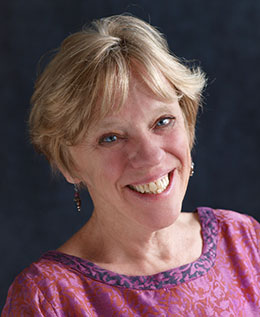
I’ve been reading Tricia Springstubb’s books ever since her first picture book, Phoebe & Digger, was published. I eagerly await each new book. They are books that resonate with many young readers: chapter books, middle grade novels, and one picture book. They are stories of families, neighborhoods, and the changes that confront every child. They are thought-provoking, serious, and laugh-out-loud funny. I wanted all of us to know more about this intriguing author.
“She thought she knew everything there was to know about herself and Sylvie, but now she thinks maybe the real trick of seeing, the kind of seeing humans could really use, is the kind that lets you see through someone else’s eyes.”
—Moonpenny Island
“Hating someone becomes a habit as sure as loving him does. Letting go of a feeling, even a terrible one — it’s hard. It hurts.”
—Moonpenny Island
“The heck of it is, Flor? No two people see eye to eye on what happy is.”
—Moonpenny Island
Is it easy for you to remember specific feelings and details from your own childhood?
I think we’re all nesting dolls, with our earlier selves tucked away inside. I’m lucky that my childhood doll is easy to bring to light—not so much specific events or details, but how intensely I felt everything, everything, during those years. Fear, love, shyness, the desire to make my mother proud, the pleasures and confusions of friendship—it’s all waiting for me to pull out and hold in my hand.
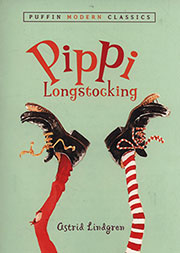 What were your favorite books to read when you were growing up?
What were your favorite books to read when you were growing up?
When kids ask me that I beg off, because I’m terrible at “favorite” questions! I was an omnivore reader—comics, mysteries, biographies of saints. I only wish I still read as widely as I did then. I remember loving, and being terrified by, Hans Christian Anderson. I read “Pippi Longstocking” over and over. It’s always fun to tell an audience of kids how I adored Nancy Drew—there are always eager nods of agreement. She’s still such a wonderful character and role model.
How old were you when you first determined you would write books? Were you always going to write books for children?
I’m still surprised to be a writer of any sort. Much as I loved books growing up, I never thought about how they came to be. They just were, like trees and rivers and birds. It wasn’t till my late 20’s that I slowly morphed from reader to writer.
Which of your earlier career experiences do you feel inform your writing?
Every job I’ve ever had (not counting waitressing) was with children. I worked in Head Start, in a group home for adolescents, in the children’s room of a public library. Kids are my people. Each experience I have with them teaches me something, and when I’m lucky, I translate what I learn into stories.
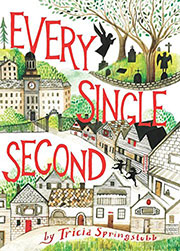 Your stories are set in neighborhoods where people know each other and rely on one another. Has this been your own experience?
Your stories are set in neighborhoods where people know each other and rely on one another. Has this been your own experience?
Sense of place is so important to my work. I grew up in a subdivision where all the houses were exactly alike and we kids ran in and out of each other’s kitchens and bathrooms and yards all day long. My husband and I raised our three daughters in an inner ring suburb much like Cody’s, where people look out for each other. So I love this kind of small, sheltering community. Yet I’m also interested, in books like Moonpenny Island and Every Single Second, in exploring the pressures that work against insularity. I’m about mirrors, but also wide-open windows.
Your stories range from the very funny Cody, who’s just right for second and third graders, to the quite serious tale of Nella, whose neighborhood is altered forever by an accidental shooting that may be racially motivated. As a writer, how do you switch between the lighthearted tone of the Cody chapter books and the more intense tone of Every Single Second?
I began writing the Cody books as a kind of antidote to my more heavy-duty novels. I really appreciate you finding them funny—I so value funny! Cody copes with many of the same issues my older characters do, including getting along with her family and friends, and trying to understand the difference between wrong and right and then to act on it. She’s also hugely empathetic, with people and animals (including baby skunks and Madagascar hissing cockroaches). But I do keep things light and fun, and this is just another side of me as both a person and a writer.
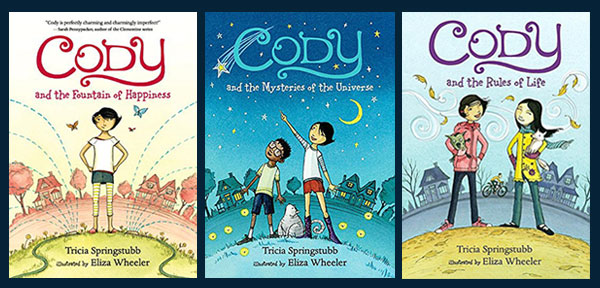
Your Cody books (there are three now) are a series. Did you write the first one (Cody and the Fountain of Happiness) and then determine with your editor that these would become a series or did you set out to create a character who could sustain a series?
I wrote the first book with fingers crossed it would be a series. I knew Cody and Spencer had lots more stories to tell! Liz Bicknell at Candlewick gave me a two-book contract and then (hooray!) extended it to four.
How do you develop the plots of the different books in a series?
I had an idea to write one book for each of the seasons. And I wanted the last book (coming spring 2018) to have some sense of closure. But other than that—I don’t know! The characters just lead me on.
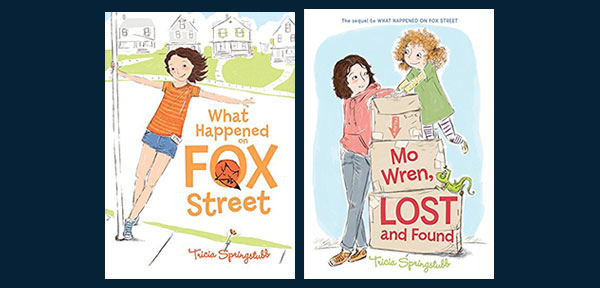
Fathers are pivotal characters in your books.
- In the Cody books, her father is an over-the-road trucker. His homecomings are very important to the plot because he often provides good counsel.
- In the Mo Wren books, Mo’s mother died in an accident. Her father is dealing with grief and starting life over.
- In Every Single Second, the father has a secret that plays a pivotal role in Nella’s coming to terms with her changing world.
- In Moonpenny Island, when Flor’s mother takes an extended leave from the family to find herself, Flor’s father, the island’s police officer, is left to manage.
I think your books are refreshing with this prominence of fathers. Have you thought about why the fathers are in your stories?
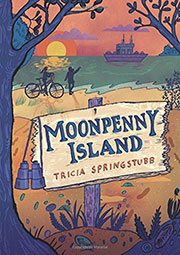 I’m always afraid when I submit a new manuscript that my editor will say, Here we go again—another father book! My relationship with my own father was complicated and not always happy. When I was small, he was my super-hero. As I grew up, I never doubted that he loved me and my siblings, but he wasn’t always the father I longed for and needed. Now, in hindsight, I can see the pain he must have been in himself, but I still clearly remember how confusing it was to realize he wasn’t, after all, perfect, that he had his own weaknesses. I think all kids go through some version of this in the tween years (not Cody, not yet!) and maybe it’s even more complicated for daughters than sons. That complexity, that mixture of love and regret and growing self-reliance, is something I keep exploring.
I’m always afraid when I submit a new manuscript that my editor will say, Here we go again—another father book! My relationship with my own father was complicated and not always happy. When I was small, he was my super-hero. As I grew up, I never doubted that he loved me and my siblings, but he wasn’t always the father I longed for and needed. Now, in hindsight, I can see the pain he must have been in himself, but I still clearly remember how confusing it was to realize he wasn’t, after all, perfect, that he had his own weaknesses. I think all kids go through some version of this in the tween years (not Cody, not yet!) and maybe it’s even more complicated for daughters than sons. That complexity, that mixture of love and regret and growing self-reliance, is something I keep exploring.
Your language is often poetic, with phrases that capture the reader’s imagination, pausing for a moment to consider the images that you evoke. Do you collect words and phrases to draw from? Do you read poetry?
Thank you! Language is so important to me. My work is very sentence-y. I hope to make every line count. I naturally reach for similes and metaphors: it’s my way of trying to connect our inner and outer lives. I do read poetry—but I’m always resolving to read more of it!
There are always a fully developed set of neighborhood characters in your books, dependable because they have such intriguing stories of their own. How do you develop these supporting characters? Do you keep a notebook full of interesting people and then find them good homes in your books?
I do keep notebooks! But writing minor characters is easy for me. The tricky part is not getting too interested in them, so they attempt to stage a coup and become major characters. In my first drafts, I’m always trying to balance what I think should happen with the zillion other possibilities. I’m the boss of this universe, after all! That said, in my current work in progress, a new character has just appeared, literally standing in the middle of the road. I have the feeling he’s not budging.
Cody’s mother is Head of Shoes at a department store. Cody often remarks on her mother’s outfit and her shoes. Your illustrator, Eliza Wheeler, often draws the mother in her stylin’ finery. Where does this fashion statement come from?
I’m so not a fashion icon (ask my daughters)! But a great part of the fun of writing is creating characters you’ll never be. I love thinking up Mom’s glam outfits. And Eliza’s illustrations are so delectable!
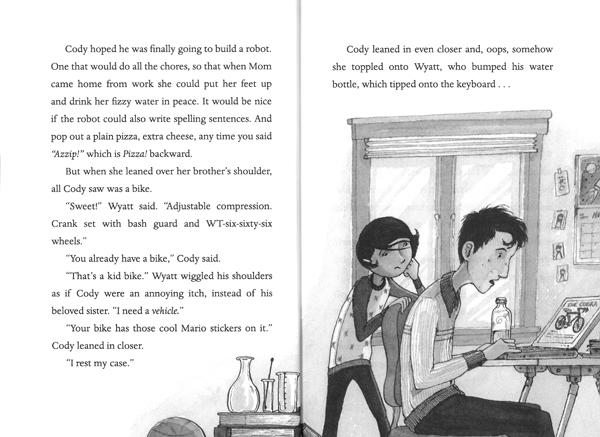
Another important aspect of your books is that each main character has a brother or sister, older or younger, with whom they bicker but ultimately love deeply, showing that love in their actions and thoughts. Your characters, although their worlds are changing around them, never feel isolated because they have a sibling to love. Why is this important to you in building your stories?
I come from a big family—two brothers and two sisters. My siblings were constant sources of annoyance, envy, and outright fury, but what would I ever have done without them? There’s something about sharing a nest that stays with you the rest of your life. Nothing makes me happier than listening to my three grown daughters, who drove each other crazy growing up and are best friends now, share childhood stories. In my work in progress, my main character is an only child, and she’s fine with that. I’m really enjoying writing her and exploring what other kinds of connections she makes with the world.
Can you share with us which books we can look forward to next?
Next April the last Cody book, Cody and the Heart of a Champion, will publish. I’ve got a picture book (hardest thing for me to write) in the works, and a new middle grade novel that I’ve just torn completely to pieces and started over. I’d also love to write a book with a boy as a main character, something I’ve yet to pull off. As Stevenson wrote, “The world is so full of a number of things, I’m sure we should all be as happy as kings.”
___________________
Tricia, thank you most of all for writing books that are worth cherishing as children grow into adults. I believe they’re books they’ll carry with them for all of their lives because you’re talented enough to be funny and caring enough to write about the big questions that really matter to kids.
Learn more about Tricia Springstubb.

Thank you for introducing me to this author!